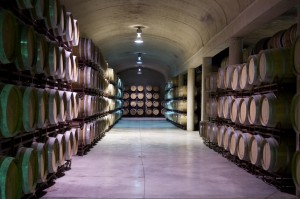by Fred Minnick
When wine historians assess the contributions of private wineries to a region, Vinicola de Castilla might very well have had the greatest impact on a Spanish wine region.

Formed in 1976, Vinicola de Castilla entered the winemaking scene when La Mancha cooperatives were mostly focusing on bulk wine. Back then, farmers, who belonged to cooperatives, were concerned with grape quantities and not interested in the winery operations, says Daniel Lulla, export manager for Vinicola de Castilla.
Then, Vinicola de Castilla, based in Manzanares, Ciudad-Real, built a state-of-the-art winery that includes 18 20-million-gallon stainless steel vinification tanks and 24 stainless steel aging vats. The winery had pressure gauges, a high-speed bottling line and was computerized. It gave the winemaker wonderful tools to make wine with and greatly influenced a resurgence of quality winemaking procedures.
They also selected nice land. The area has underground rivers flowing under its 100 hectares of vines, feeding the limestone-rich sandy loam soil.
“The {founders} had a clear picture of how to make a winery the most modern winery to produce a very high quality wine at an price,” Lulla says. “Back then, few wineries were able to produce wine at good quality.”
Many winemakers in the region credit Vinicola de Castilla for putting the pressure on the rest of the private winemakers to make high-quality wine.
Today, the trendsetting winery continues to make a difference in the region. It has won more than 500 international awards and has earned ISO 9001:2000 certification, guaranteeing the packaging and commercialization of its products. It also has the BRC-A certification for food, which facilitates standardization of quality, safety, operational criteria and manufacturers’ fulfillment of legal obligations.
It’s the only winery in La Mancha to have both certifications. This means that when you see Vinicola de Castilla on the label there are several levels of standardization.
In addition, Vinicola de Castilla is experimenting with growing Malbec, making it one of a handful of producers attempting the grape, while also growing Airen, Macabeo, Chardonnay, Sauvignon Blanc, Moscatel, Verdejo, Riesling, Tempranillo, Cabernet Sauvignon, Merlot, Garnacha, Syrah and Petit Verdot.
The wine is consistently good and captures Ciudad-Real’s vast flavor profiles that range from the juicy Tempranillo to the floral Verdejo. They produce seven labels, including DO La Mancha brands Señorio de Guadianeja, Castillo de Manzanares, Finca Vieja, Castillo de Alhambra, Balada and Cantares (sparkling wine), that are among the best in the region. As they did when they first started, Vinicola de Castilla strives for quality first, Lulla says.
Select Tasting Notes

Castillo de Manzanares Reserva 2003
A bright red color, this Tempranillo is rich and luscious, velvety and filled with raspberry and strawberry notes with hints of coffee and cinnamon.
Señorio de Guadianeja Tempranillo 2009
This deep crimson-colored Tempranillo emits aromas of spice box and cherry, while giving the palate licorice, black fruits and a smooth finish. This young wine is meant to be enjoyed in the next three years.
Señorio de Guadianeja Verdejo 2009
A bright straw color is followed by aromas of herbs, ripe fruit. It’s fleshy and wet, with a slight hint of clove.








